Oceania
| surface | 397,000 km² |
|---|---|
| population | 8.5 million |
| Population density | 17 inhabitants / km² |
| countries | |
| Time zones | UTC + 10 ( Solomon Islands ) to UTC-6 ( Easter Island ) |
Oceania is the name given to the islands of the Pacific north and east of the continent of Australia . The more than 7,500 islands together cover a land area of 397,000 square kilometers and extend over a sea area of around 70 million square kilometers. Around 2100 of the islands are inhabited. 16.5 million people live there. Together with Australia, Oceania forms the greater continental region of Australia and Oceania .
term
Oceania
The extent of the area belonging to Oceania is defined differently. In the most common German-language definition, only Polynesia , Melanesia and Micronesia belong to Oceania. Both New Zealand and Hawaii are assigned to Polynesia, as both were settled by Polynesians, who were of great importance for their cultural development. This is also true today, although New Zealand has strong European traits due to European immigration and Hawaii is part of the American economic area. The classification thus excludes the East Asian island chains as well as those of the Malay Archipelago , which have different cultural landscape developments with different historical, economic and social characteristics.
The east of the Malay Archipelago is rarely included. Occasionally - and especially in the English language - are Australia and Oceania also shortened as Oceania ( Oceania ), respectively.
The area owes its peculiar nomenclature to the apparent distance to other continents. In order to combine the cultural identity of the indigenous peoples of the Pacific world in one term, the name Austronesia was previously used for the South Sea islands inhabited by Māori and other Polynesian peoples. Gradually, the term was extended to other areas.
Transoceania
In English, the term transoceania is also used . This term originated mainly for economic reasons in Australia and New Zealand and describes an area from northern Australia via Indonesia to the southern border of the Philippines and the far west of the Pacific islands. The region is of great importance for the industrialized countries in the south as a trade route to the developing and emerging countries of East and Southeast Asia, as well as a source of raw materials, a location for cheap production and a sales market.
South seas
The term " South Sea " was coined in 1513 by Vasco Núñez de Balboa , when he had crossed the isthmus of Panama and called the sea ( Pacific ) in front of him Mar del sur ("South Sea"), as he looked south from his location looked at the sea. Central island groups are the Society Islands ( French Polynesia / Tahiti ), the Samoa Archipelago and the Fiji Islands. The term South Seas is often used synonymously with Oceania and in the narrower sense with Polynesia (triangle with the corners Hawaii , New Zealand and Easter Island ). Other terms derived from this are common, such as the South Pacific or South Pacific island area . In the past, these often appeared in political vocabulary as self-chosen terms (e.g. South Pacific Forum , South Pacific Commission , University of the South Pacific ). Many of these names have been changed in recent years to give meaning to the entire Pacific region.
geography
geology
Oceania is not a continent in the geological sense, as only New Caledonia and New Zealand consist of the continental crust of the former continent Gondwana : New Zealand, New Caledonia and the Lord Howe Threshold with the Lord Howe Archipelago form a large piece of the former continental shelf of Gondwana, the microcontinent Zealandia . New Guinea is only separated from Australia by the shallow Arafura Sea , even during the last Ice Age they formed a coherent land mass called Sahul , as the water level in the Pacific was about 100 m lower than today.
Most of the islands of Oceania are volcanic peaks in the average 4000 m deep Pacific Ocean , often recognizable by volcanic craters on land. Sometimes the volcanoes only reach just below the sea surface and are expanded by corals to form reefs and flat islands. Often there is a volcanic islands of a belt of coral reefs are framed or rock formations from the formed of coral limestone have. Cave structures are often found here.
Volcanic activities are triggered by geological processes in the oceanic crust . The movements of the lithospheric plates in the Pacific are also the cause of the so-called Pacific Ring of Fire , on which many islands were formed, especially on its western edge. Volcanism at hotspots resulted in long chain of islands lying far in the ocean , such as the Hawaii-Emperor chain with the islands of the Kure Atoll , the Midway Islands and the Hawaiian Islands as the end point.
Deep-sea trenches , island arches and sometimes lake basins were created where subduction occurs , for example in the Pacific plate . Examples are the back-arc basin to the west of Tonga lying foliage corners and up to 10,882 meters below sea level lying Tonga Trench .
Ocean currents
At the height of the equator, the equatorial countercurrent runs from west to east in the Pacific . To the north, at the height of Hawaii, the North Equatorial Current flows from east to west . In New Guinea it turns into a northward current, flows east of the Philippines as Kuroshio and creates a huge vortex in the area of Micronesia. Part of the ocean current leaves the eddy eastward to flow to the coast of North America and return to its beginning as the north equatorial current. The south equatorial current runs south of the equator, also from east to west . This is fed by the cold Humboldt Current on the west coast of South America and partially merges into the East Australian Current , which flows along the east coast of Australia and meets New Zealand. From there an eastward current runs to South America, which is composed of warm equatorial water and cold water of the Antarctic Circumpolar Current , which runs south from Australia and New Zealand . As a result, New Zealand is surrounded by a warm ocean current in the north and a cold ocean current in the south.
climate
The tropical to subtropical Pacific islands in the east of Oceania offer little variety all year round and, thanks to their hot, humid climate, are home to a multitude of forms of rainforest. The precipitation-rich winters in the east and the monsoons in the northwest (Indonesia, Papua New Guinea ) raise the annual mean significantly here.
An exception is New Zealand, where a cool, temperate climate is predominant.
Political structure
Independent states
The Cook Islands are an independent state in "free association with New Zealand" , which is recognized by the United Nations and by over 20 states (in March 2001 also by Germany). However, the Cook Islands are not a member of the United Nations. There are many association agreements between the independent states of Oceania and other states, for example the Cook Islands with New Zealand and Palau, the Marshall Islands and Micronesia with the United States.
The only land border between two states in the entire region is in New Guinea between Indonesia and Papua New Guinea. According to the above definition, however, New Guinea is not part of Oceania.
| location | country | Capital |
Area (km²) |
Population (as of 2002) |
Inhabitants per km² |
|---|---|---|---|---|---|

|
|
Avarua | 240 | 20,811 | 87 |

|
|
Suva | 18,270 | 856.346 | 47 |

|
|
South Tarawa | 811 | 96,335 | 119 |

|
|
Majuro | 181 | 73,630 | 407 |
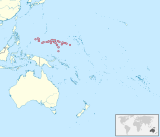
|
|
Palikir | 702 | 135,869 | 194 |
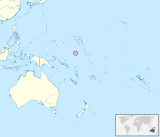
|
|
Yaren | 21st | 12,329 | 587 |
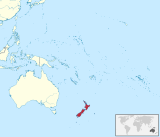
|
|
Wellington | 268,680 | 3,908,037 | 16.4 |

|
|
Ngerulmud | 458 | 19,409 | 42 |

|
|
Honiara | 28,450 | 494.786 | 17th |

|
|
Apia | 2,944 | 178,631 | 61 |
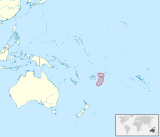
|
|
Nuku'alofa | 748 | 106.137 | 142 |

|
|
Funafuti | 26th | 11,146 | 429 |
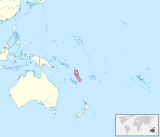
|
|
Port Vila | 12,200 | 196.178 | 16 |
Dependent areas
| location |
Country motherland |
Capital |
Area (km²) |
Population (as of 2002) |
Inhabitants per km² |
|---|---|---|---|---|---|

|
United States |
Pago Pago | 199 | 68,688 | 345 |

|
Papua New Guinea |
Buka | 9,300 | 249.358 | 27 |

|
France |
Papeete | 4.167 | 257,847 | 62 |
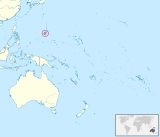
|
United States |
Hagåtña | 549 | 160,796 | 293 |

|
France |
Nouméa | 19,060 | 207,858 | 11 |

|
New Zealand |
Alofi | 260 | 2.134 | 8.2 |

|
United States |
Saipan | 477 | 77,311 | 162 |

|
Australia |
Kingston | 35 | 1,866 | 53 |

|
United Kingdom |
Adamstown | 47 | 47 | 1.0 |

|
New Zealand |
Fakaofo (Fale) | 10 | 1,431 | 143 |
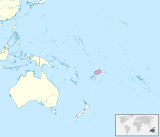
|
France |
Mata-utu | 274 | 15,585 | 57 |
| Dependent areas (uninhabited islands) | |||||

|
Australia |
Willis Island Weather Station |
3 | 4 ward staff |
1.3 |

|
United States |
no | 28 | 40 Scientific staff |
1.4 |

|
France |
no | 1.7 | uninhabited | 0 |
| Subnational administrative units of predominantly non-ocean states | |||||

|
United States |
Honolulu | 28,311 | 1,285,498 | 45 |

|
Chile |
Hanga Roa | 164 | 3,791 | 23 |
Flora and fauna

Oceania's flora and fauna are divided into two parts. On the one hand there is the Australian fauna and flora, with for example the marsupial and monastery , which extends to the so-called Wallace Line in the Malay Archipelago , on the other hand there is the world of the small islands in the Pacific, where land plants and animals only go by sea can be washed ashore. There can adaptive radiation are observed, the fanning a little specialized kind to the existing environmental conditions in many more specialized species. Flightless birds are a frequent occurrence in the absence of large, ground-dwelling predators.
The marine fauna and flora is characterized by a great variety. Well-known natural areas are the Great Barrier Reef , the Coral Triangle , East Rennell , the Lord Howe Archipelago and the Northwest Hawaiian Islands .
Many animal and plant species in Oceania are only native to small regions and are therefore considered endemic . These are often threatened with extinction by introduced animals such as dogs, cats, pigs or rats. An example of this is the New Caledonian kagu . This naturally lays few eggs, as it originally had no enemies. When rats were introduced from Europe, they ate what was easy prey for them and the kagu population sank threateningly. Only strict protective measures saved the species.
Further threats are the deforestation of the forests in the interior of the islands, climate change with the rising sea levels and changes in habitats and illegal fishing methods.
population
Indigenous peoples of Oceania
The indigenous peoples of Oceania include:
- the aborigines of Australia :
- Melanesians in Melanesia , e.g. B .:
-
Micronesians in Micronesia , e.g. B .:
- Chamorro in the Mariana Islands
- Nauruer on Nauru
- Papua in New Guinea , e.g. B .:
-
Polynesians in Polynesia , e.g. B .:
- Māori in New Zealand
- Tongans on Tonga
The multicultural situation
The indigenous peoples of Oceania find themselves in very different situations. While they are only a small minority in Hawaii, for example, the proportion of Māori in New Zealand is still just under 15%. On the Northern Mariana Islands the Micronesians only have a population of 21.3%. New Guinea has largely an indigenous population, as do most of the South Sea islands, with Indonesian immigration from the west of the country to western New Guinea increasing and leading to conflict.
Europeans make up the majority in Australia, New Zealand and Hawaii. Large European minorities live in New Caledonia (34%) and French Polynesia (12%).
In the Fiji Islands, Indians are a minority of 38.2%. In the Northern Mariana Islands, the Filipinos make up the largest population group with 26.2%, the Chinese the second largest with 22.1%. In other Pacific island states, too, the proportion of the population that comes from Asia is increasing significantly as a result of immigration.
economy

If you look at the most widely used definition of the term, Australia is the economic core of the continent. Along with New Zealand, it is also an internationally important technology location. The smaller emerging island states are increasingly shifting their economic infrastructure to the area of services. The charm of the Pacific South Sea islands is an attractive aspect for tourism, regionally up to 95% of GDP is directly or indirectly related to tourism. The transoceanic import of labor goods is on the one hand an economic brake for the countries of the first world, but secures the supply of the dependent micro states, which can produce very little, mainly agricultural export goods (medicinal raw materials, coconuts). Freight traffic between the islands proves to be particularly difficult, which rarely takes place with small seaplanes and mainly with cargo ships or ferries. Telecommunications and broadcasting are also only developed in the few, more densely populated areas. In the more remote areas, there is an increasing number of high illiteracy rates (50% in Wallis and Futuna ). These islands, mostly inhabited by indigenous peoples, are mostly politically dependent, forgotten self-sufficient areas.
history
Pre-colonial history
It is believed that modern humans first settled the Australian continent at least 65,000 years ago . Until about 35,000 years ago, the first settlement was completed via the continuous land connection from New Guinea to Tasmania. It is believed that parts of the Solomon Islands were also settled back then.
A second wave of immigration began when from around 1500 BC. BC Melanesia and Micronesia were populated by people speaking Austronesian languages . They reached Polynesia around the year 0, Hawaii between the second and sixth centuries, Easter Island in the fifth or sixth centuries, and New Zealand between the 11th and 13th centuries.
From the 16th to the 18th century the European research trips followed by Portuguese , Spanish , Dutch , French and British .
Colonial history
From the 18th century, European trade intensified. Former sailors or fugitives on the run lived as sandpipers on the fringes of local society and served as intermediaries and translators between locals and Europeans.
In the 19th century the occupation and colonization by the European powers began. Oceania was divided among the British, Dutch, Spanish, French, Americans, Japanese and Germans. Agriculture was converted to the production of colonial goods where possible . For example, sugar cane plantations emerged in Fiji . In the system of indentured labor, the required cheap labor could initially be covered by volunteers, while later coercion ( blackbirding ) was also used. In the period from 1879 to 1916, around 60,000 Indian workers came to Fiji to work alongside Oceanians in the plantations. More than 60,000 Oceanians, mostly from the Solomon Islands and the New Hebrides , were brought to Queensland as cheap labor .
The Spanish-American War led to a wild change of sovereignty over the Pacific regions at the end of the 19th century . The defeat in World War I forced Germany to give up its colonies , which were divided up among the victorious powers. The Pacific War during World War II caused great devastation in the affected regions. After the war ended, Japan had to give up its possessions in Oceania. They came under the administration of the United States as UN trust territories .
In the second half of the 20th century, the colonies and trust territories of the Netherlands, Australia, Great Britain and the USA were granted independence, although some states still have close ties to the former colonial power. The last European possessions are French Polynesia, Wallis and Futuna, New Caledonia (France) and the Pitcairn Islands (Great Britain).
Arts and Culture
Since no script was known among the indigenous peoples of Oceania - with the exception of the previously undeciphered Rongorongo script from Easter Island - art played a very important role. History was recorded and passed on through painting and carving. Body decoration and painting in particular were an expression of individualism and beauty. Tattoos were especially common among Polynesians. Much of the original culture disappeared in the course of colonization and the subsequent Christianization of the indigenous population.
Polynesian and Māori art

Art was very closely linked to practical use. Although purely decorative works were also produced, the main focus of artistic creation was placed on the jewelry of everyday objects. The most common form of expression in Polynesian art was carving. Of central importance was the decoration of the waka , the outrigger canoe of the Polynesian peoples. These were shown with particular pride, but lost importance with the arrival of the Europeans due to their large, modern ships. Later, the focus was on the decoration of the meeting houses, with the design of totems around the ancestor cult . The high social recognition of the craft was connected with a respect for the artists. Most of the time only tools like sharp shells and stones were available for carving. It was not until the Europeans that metal tools became widespread, with which the Polynesians also worked on materials such as jade . This was made into jewelry and tools and also richly decorated.
Another art form of Polynesia is the tattoo, which used to reflect a person's status. The larger and more intricate the so-called moko , the higher the rank of the person who wore it. The patterns (mostly spirals or shell-like shapes) were pushed into the meat with a hammer and mallet and rubbed with fresh soot. Women were for the most part denied these types of art. The only appropriate form of creative work for women was weaving. The flax fibers were colored differently and woven into complex patterns.
literature
- Adrienne L. Kaeppler, Christian Kaufmann, Douglas Newton: Oceania. Art and culture . Herder, Freiburg 1974, ISBN 3-451-22974-9 .
- Éric Conte: Tereraa: Voyages et peuplement des îles du Pacifique . Éditions Polymages-Scoop, Tahiti 1992, ISBN 2-909790-04-5 .
- Hermann Mückler, Ingfrid Schütz-Müller: The discovery of the South Seas in the mirror of old maps, views and travel reports . Museum for Ethnology, Vienna 1997, ISBN 3-901005-07-2 .
- Arnaud Noury (Ed.): Le Reflet de l'âme lapita, archeologie du lapita en Océanie . Versailles 2005, ISBN 2-9524455-0-8 .
- Christophe Sand, Patrick Vinton Kirch: L'Expédition Archéologique d'Edward W. Gifford et Richard Shutler, Jr. en Nouvelle-Calédonie au Cours de l'Année 1952 . In: Les Cahiers de l'Archéologie en Nouvelle-Calédonie , Volume 13. Département archeologie, Service des musées et du patrimoine de Nouvelle-Calédonie, Nouméa 2002, ISBN 2-9509311-9-7 .
Web links
- Database of indexed literature on the social, political and economic situation in Oceania
- DFG special collection area Oceania at the Frankfurt University Library with commented web links
- Link catalog on Oceania at curlie.org (formerly DMOZ )
- German-Pacific Society, Munich (country information)
- Interesting satellite images u. v. m.
- World Culture Encyclopedia / Oceania
Individual evidence
- ↑ Werner Kreisel: The Pacific island world - a geography . 2nd Edition. Gebr. Borntraeger, Berlin, Stuttgart 2004, ISBN 3-443-01052-0 , p. 1 .
- ↑ Werner Kreisel: The Pacific island world - a geography . 2nd Edition. Gebr. Borntraeger, Berlin, Stuttgart 2004, ISBN 3-443-01052-0 , p. 3 .
- ↑ Jan Steffen: Christmas in the Western Pacific. In: GEOMAR. Helmholtz Center for Ocean Research, December 10, 2018, accessed on May 7, 2019 .
- ↑ The international legal status of the Cook Islands auswaertiges-amt.de
- ^ Diplomatic relations with Germany Auswärtiges-amt.de
- ↑ fakaofo.tk
- ↑ Nicholas St. Fleur: Humans First Arrived in Australia 65,000 Years Ago, Study Suggests. In the New York Times on July 19, 2017.
- ↑ Emma Willoughby: A "White Australia" ( Memento of March 7, 2005 in the Internet Archive ) (PDF).









